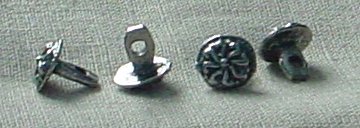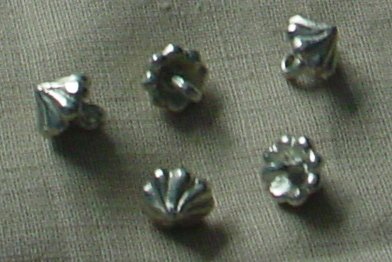Fastenings
Points
The most common method of fastening, especially for men, is the point. This is a piece of cord with both ends neatly finished, often with a metal end attached known as an eyglet or aiglet. This is passed through two sets of holes on the two edges of the garment, to be joined and tied with a half-bow. They are used to attach hoes to a doublet, to do up doublets, to close pouches and do up shoes. They are everywhere really. To fasten a garment with them you should put pairs of holes at intervals down both sides of the opening, rather than rows of even spaced holes.Cords
These are used for points, lacing dresses, drawstrings in pouches etc. and can be made by various methods. The best way is to make your own: you can make lucet cording out of linen thread, use linen thread to make thin rope to cut down or do five finger weaving. Alternatively, use leather thonging. I would advise using either thick linen or thick wool while using the lucet to provide cording for doublets and hoes.Hooks and Eyes
These were very uncommon until the end of the 15th Century, so I would advise you not to use them on anything but a high end garment and only when they cannot be seen. I think that they would be fine to use on Tudor garments.Buttons



Another common fastening is the button. Cloth buttons were common; they vary in size from very tiny to chunky and are made from circles of cloth sometimes with a former (disk of wood or bone) or extra cloth inside to pad it out. Other materials, such as wood, bone and metal were also used. The metal ones are often more expensive and often have long shanks. In this case, the buttons are not sewn on but, instead, a set of eyelets is worked where the buttons are to go, the shanks are passed through these holes and they are all attached together by a piece of cord running along the inside. This makes them flat and enables them to be used on more than one garment. Pewter buttons should be used in moderation due to the expense.
Eyelets and buttonholes

These must always be hand worked. Eyelets are simply small holes strengthened with overcast stitch or buttonhole stitch. Buttonholes are simply slits edged with buttonhole stitch. Don't use strengthening techniques such as thread bars at the ends as it is not clear when they started being used. You may use extra material in your garment to strengthen these holes.
